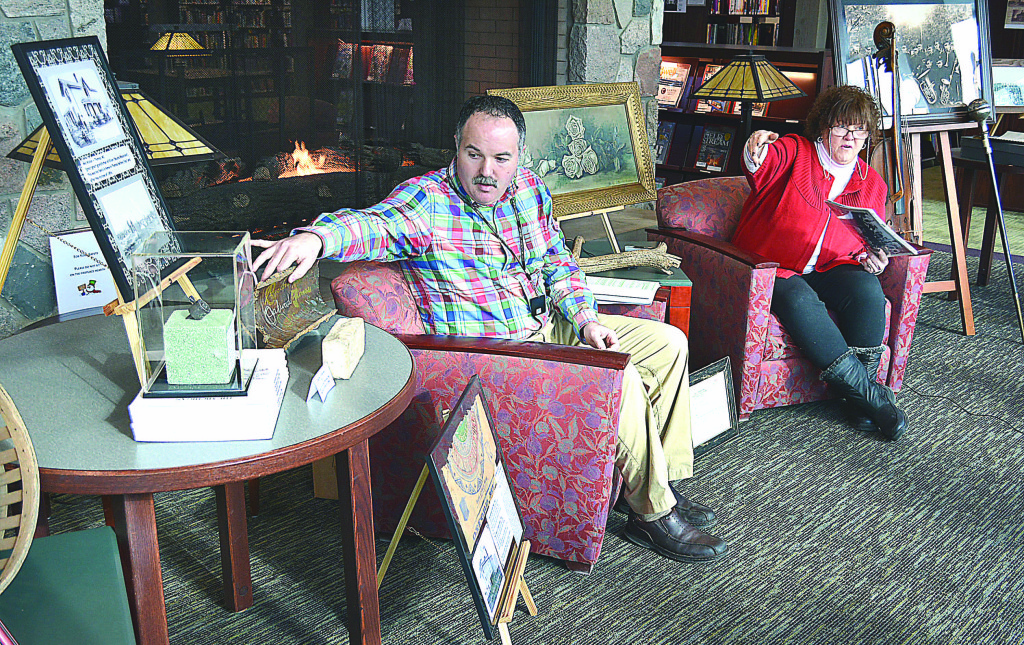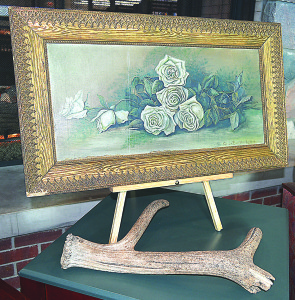
It may seem hard to believe, but there’s something on display at the Northeast Oakland Historical Museum in downtown Oxford that predates the ancient civilizations of Egypt, Greece and Rome.
On Friday, this item took a little field trip to the Oxford Public Library for a fireside chat about the museum and this community’s history.
The item is a fossilized elk antler discovered decades ago in a cedar swamp in northern Oxford.

In 1975, the Cranbrook Institute and University of Michigan identified the species and estimated the fossil to be between 10,000 and 15,000 years old.
“It’s quite amazing that we have something that old in the local museum,” said library Director Bryan Cloutier, president of the historical society. “Things that age you would expect to be in museums in Detroit or Chicago or New York, but not in Oxford.”
Cloutier led the fireside chat along with Oxford Village President Sue Bossardet, the historical society’s treasurer.
The pair brought a mixture of artifacts and photographs from the museum to help the audience visualize things during their brief journey through Oxford’s history, which begins with the first settlers in the early 1830s. The township came into existence in April 1837. The village’s incorporation followed in 1876.
The arrival of the railroad in the early 1870s helped transform Oxford into a hopping community where crops were grown and shipped, machinery was manufactured and newspapers were printed.
At one point, the community even had its own cereal company on Louck St. known as Oxford Flakes.
Oxford’s largest industry, gravel mining, began in 1911. In the coming decades, the community would have as many as five companies mining the bounty left behind by ice-age glaciers. Shipping 5 million tons of gravel annually led to Oxford’s nickname, “Gravel Capital of the World.”
Oxford was definitely a destination in the olden days as evidenced by the fact there was a hotel downtown.
“This was a bustling city – much different than it is now,” Bossardet said.
But the community still experienced its share of setbacks.
One of those came on May 25, 1896, when a tornado – or cyclone as it was called back then – ripped through Oxford, devastating the unincorporated villages of Oakwood and Thomas, which were thriving towns at the time. The cyclone caused more than $1 million in damage and claimed more than 40 lives, according to Bossardet.
“The houses out there and the buildings, the businesses, they were just leveled,” she said.
One of the museum’s more unique treasures is a postal cancellation stamp used back when Oakwood had its own post office. Still bearing the date of when the cyclone hit, it was found many years later by a local farmer while plowing a field. Today, it sits in a special case at the museum, a chilling reminder of the raw and untamed power of nature.
But not every interesting artifact at the museum has a tale of woe attached to it.
One of Cloutier’s favorite items is the original handwritten sheet music for Oxford High School’s “Blue and Gold Fight Song,” composed and arranged by Martin Kozak, who was just a 17-year-old senior at the time.
Kozak, who’s family name was originally Kozachik, went on to serve in World War II and later become a medical doctor. From the mid-1950s until his death in 1992, he served as a family physician in Portland, Michigan.
The song was approved and adopted as the official fight song by the board of education on May 2, 1944. The sheet music is signed by then-School Board President G.E. Meads, a well-known local dentist who helped charter the Rotary Club of Oxford in 1937 and served as its first president.
“I think it’s really cool the museum has this kind of material in its archives, (preserved) for generations to come,” he said.
Cloutier encouraged folks to join the historical society, founded in 1971, and become “stewards of Oxford’s treasures.”
“We are always looking for individuals who have an interest in history,” he said.
Volunteers are needed to serve as museum docents and help care for the artifacts. Folks with expertise and experience as archivists and preservationists are particularly welcome.
The Northeast Oakland Historical Museum is located at 1 N. Washington St. in the building that housed the Oxford Savings Bank from 1922-66. It’s open on Thursdays and Saturdays from 1-4 p.m. Field trips and group tours are available by appointment. Please call (248) 628-8413.
“If you haven’t had the opportunity to visit the museum, we certainly would encourage you to do so,” Cloutier said.

Leave a Reply